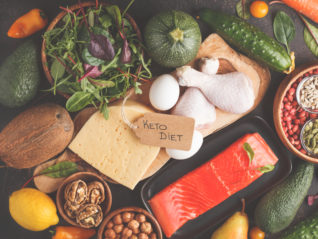
Ketone bodies (including acetoacetate, β-hydroxybutyrate and acetone) are produced mainly by the liver from fatty acids during fasting, prolonged physical activity, starvation, or ketogenic diets (diets that restrict carbohydrates to usually < 50 g/day). The metabolic state in which ketone bodies are utilized as the main energy source for the body instead of glucose is called ketosis. Physiological or nutritional ketosis has been shown to lead to several metabolic advantages including weight management and improvements in glycemic control and blood lipids.1
An article published in Cell Chemical Biology demonstrates a novel biological function for ketone bodies: neutralizing methylglyoxal (MG), a highly reactive metabolite of glucose metabolism known to be involved in aging- and diabetes-related diseases.2
MG has been shown to react with and cause damage to DNA and proteins, forming advanced glycation end products (AGEs) that are linked to many aging-related pathologies.3 Levels of MG are elevated in patients with type 2 diabetes (T2D) as well. An interdisciplinary team of researchers from Aarhus University (Aarhus, Denmark) found that, when ketosis was induced in diabetic patients, the generated ketone body acetoacetate efficiently reacted with MG in the blood and formed a new compound called 3-hydroxyhexane-2,5-dione (3-HHD). 3-HHD was then broken down to less-reactive species by the blood cells.
The investigators then studied healthy individuals who were placed on a ketogenic diet, and found that the ketone body acetoacetate generated during nutritional ketosis also reacted with MG and formed 3-HHD. These observations suggest that acetoacetate is a MG scavenger during pathological conditions such as diabetic ketosis, as well as during nutritional ketosis in healthy individuals.
This groundbreaking study expanded the known biological functions of ketone bodies. However, whether eliminating MG via ketosis would lead to significant clinical benefits and healthy aging requires further studies and clinical trials.
References
- Paoli A et al. Beyond weight loss: a review of the therapeutic uses of very-low-carbohydrate (ketogenic) diets. Eur J Clin Nutr. 2013;67(8):789-796.
- Salomon T et al. Ketone body acetoacetate buffers methylglyoxal via a non-enzymatic conversion during diabetic and dietary ketosis. Cell Chem Biol. 2017;24(8): 935-943 e7.
- Maessen DE, Stehouwer CD, Schalkwijk CG. The role of methylglyoxal and the glyoxalase system in diabetes and other age-related diseases. Clin Sci (Lond). 2015;128(12):839-861.




